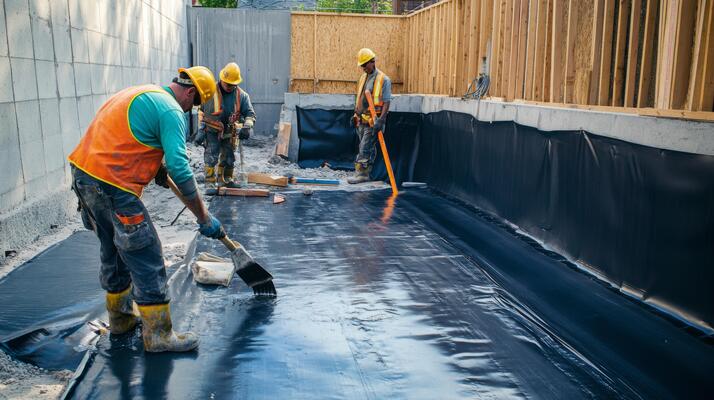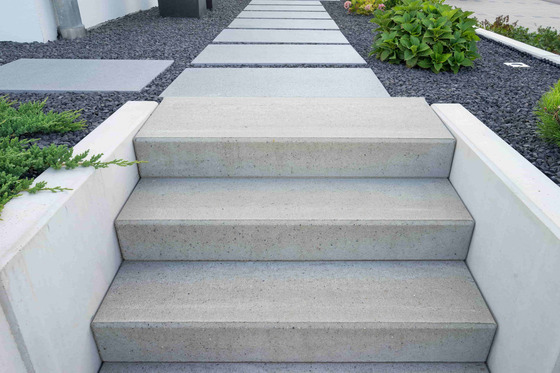Different Types of Waterproofing in Construction

Waterproofing plays a vital role in construction and maintenance, ensuring that buildings remain durable and last longer. It safeguards structures against water damage, stops leaks, and preserves the integrity of surfaces in homes, offices, and industrial environments. Whether you’re building a new property or updating an existing one, knowing the different types of waterproofing can help you make better choices. In this blog, we’ll look at the five most commonly used types of waterproofing, their uses, and why they could be the best option for your project.
Must Read: Under Deck Waterproofing DIY
5 Common Types of Waterproofing Popularly Used
Liquid Waterproofing Membrane
This waterproofing method consists of applying a liquid coating that creates a seamless protective layer as it cures. It is very flexible and can conform to different shapes and surfaces. Liquid waterproofing is commonly used for roofs, balconies, and basements because of its straightforward application and outstanding performance.
Advantages:
- Seamless application reduces leak points.
- High durability and flexibility.
- Suitable for complex shapes and areas.
Best For: Roofs, terraces, and exposed surfaces requiring extra protection.
Cementitious Waterproofing
Cementitious waterproofing is a simple yet effective method that combines cement with concrete waterproofing compounds. It’s particularly useful in areas that are frequently exposed to water, like bathrooms and water tanks.
Advantages:
- Simple and cost-effective.
- Easily available materials.
- Resistant to water pressure.
Best For: Bathrooms, kitchens, swimming pools, and water tanks.
Bituminous Waterproofing
Bituminous waterproofing utilizes bitumen-based materials available as rolls, sheets, or liquids. It is a great option for locations that need enhanced durability and water resistance.
Advantages:
- Strong adherence to surfaces.
- High resistance to water penetration.
- Cost-effective for large areas.
Best For: Roofs, basements, and industrial areas.
Polyurethane Waterproofing
Polyurethane is an excellent waterproofing solution recognized for its strength and adaptability. It is applied in liquid form, which then cures into a continuous layer, providing strong protection.
Advantages:
- High flexibility and elongation properties.
- Seamless application for effective coverage.
- UV and weather-resistant.
Best For: Flat roofs, balconies, and terraces.
EPDM Rubber Waterproofing
Ethylene Propylene Diene Monomer (EPDM) is a type of synthetic rubber commonly used for waterproofing applications. It is recognized for its excellent performance and environmentally friendly properties, making it a popular option for durable waterproofing solutions.
Advantages:
- Excellent UV and ozone resistance.
- Long lifespan with minimal maintenance.
- Environmentally friendly option.
Best For: Green roofs, commercial buildings, and industrial applications.

Conclusion
Selecting the right waterproofing method is crucial and should be based on the specific requirements of your project, the structure type, and the level of exposure to water and weather. There are various options available, from liquid membranes to cementitious solutions, each providing distinct advantages that can improve the durability and integrity of your property. Whether you’re involved in a home renovation or a large commercial endeavor, choosing the right waterproofing solution will give you peace of mind and long-lasting protection. If you’re uncertain about which method is best for your needs, it’s wise to consult a professional waterproofing contractor for guidance.
Easy Steps to Waterproof Concrete Stairs from Water Damage

Concrete stairs, while durable, are susceptible to water damage over time. Water infiltration can lead to cracks, erosion, and structural issues, compromising both safety and aesthetics. Implementing effective waterproofing measures is essential to extend the lifespan of your concrete stairs and maintain their integrity.
Steps to Waterproof Concrete Stairs to Prevent Water Damage
Waterproofing concrete stairs is crucial for preventing water damage, enhancing durability, and maintaining safety. Follow these steps to ensure your stairs are protected from moisture and weather-related wear.
Step 1: Clean and Prepare the Stairs
Begin by thoroughly cleaning the concrete surface to remove dirt, debris, and stains. Use a pressure washer or a stiff-bristle brush with a mild detergent solution. Ensure the stairs are completely dry before proceeding, as moisture can hinder the effectiveness of the waterproofing materials.
Step 2: Repair Any Cracks or Damage
Inspect the stairs for any cracks, chips, or surface imperfections. Use a concrete patching compound to fill and repair these areas, following the manufacturer’s instructions. Allow the repairs to cure fully before moving on to the next step.
Step 3: Apply a Waterproofing Sealant
Selecting the appropriate sealant is crucial for effective waterproofing. Common types include:
Penetrating Sealers: These sealers absorb into the concrete, providing protection from within without altering the surface appearance. They are ideal for preserving the natural look of the stairs.
Acrylic Sealers: Forming a protective film on the surface, acrylic sealers are suitable for both indoor and outdoor applications. They offer UV resistance and are available in various finishes.
Polyurethane Sealers: Known for their durability and resistance to chemicals and abrasion, polyurethane sealers are excellent for high-traffic areas. They provide a glossy finish and robust protection.
Apply the chosen sealant evenly using a brush or roller, ensuring complete coverage. Follow the manufacturer’s guidelines regarding application techniques and the number of coats required.
Read More Blogs: Five Benefits to Waterproofing Your Concrete
Step 4: Allow Proper Drying Time
After application, allow the sealant to dry and cure as per the manufacturer’s recommendations. This period is essential for the sealant to form an effective barrier against moisture. Avoid using the stairs during this time to prevent any disturbances to the curing process.
Step 5: Routine Maintenance Tips
Regular maintenance is vital to ensure the longevity of the waterproofing:
Periodic Cleaning: Keep the stairs free from dirt and debris by cleaning them regularly.
Inspect for Damage: Periodically check for new cracks or signs of wear and address them promptly.
Reapply Sealant: Depending on the type of sealant used, reapplication may be necessary every few years to maintain optimal protection.
Is Asphalt Good for Waterproofing Concrete Steps?
Asphalt, particularly in the form of mastic asphalt, is an effective material for waterproofing concrete steps. It provides a durable, flexible, and impermeable layer that protects against water infiltration. However, applying asphalt requires professional expertise to ensure proper installation and longevity.

Advantages of Using Professional Concrete Step Sealing Services
While DIY methods are feasible, hiring professionals offers several benefits:
Expertise: Professionals have the knowledge to select and apply the most suitable waterproofing materials for your specific situation.
Quality Assurance: Professional services ensure thorough application, reducing the risk of missed spots or improper sealing.
Time Efficiency: Professionals can complete the job more quickly and efficiently, minimizing disruption.
Conclusion
Waterproofing concrete stairs is a proactive measure to prevent water damage and extend their lifespan. By following the outlined steps—cleaning, repairing, sealing, and maintaining—you can protect your stairs from the detrimental effects of moisture. Considering professional services can further enhance the effectiveness and durability of the waterproofing efforts.
For expert assistance in waterproofing your concrete stairs, consider reaching out to Capital Deck & Stair. With over 30 years of experience, they specialize in high-quality deck, stair, and balcony coating services. Contact Us today at (866) 582-6705 or visit our website to schedule a free estimate.
Top Four Signs Your Business Needs Concrete Waterproofing & Resurfacing in Los Angeles

Are you a business owner in Los Angeles? Is your property showing signs of wear and tear? It might be time to consider concrete waterproofing and resurfacing. In this blog, we will discuss the top four signs that indicate your business needs this essential maintenance. From water damage to cracks and uneven surfaces, we will cover it all.
Concrete waterproofing and resurfacing are crucial to protect your property from further damage and ensure its longevity. You don’t want to wait until it’s too late and costly repairs are needed. By taking preventive measures now, you can save yourself time, money, and headaches in the future. But how do you choose the right professionals for the job? We will guide you through the process of finding the best waterproofing contractors in Los Angeles.
So, let’s dive in and discover how you can protect your business with concrete waterproofing and resurfacing.
Signs Your Business Needs Waterproofing
If you’re constantly battling leaks and water damage in your business, it’s high time you consider waterproofing. Water intrusion can cause significant damage to your property and disrupt your operations. One sign that your business needs waterproofing is the presence of water stains or discolouration on your walls or ceilings. These unsightly marks not only give a poor impression to customers but also indicate a potential water leak. Another sign is the presence of mould or mildew, which thrives in damp environments. Mould not only poses health risks but also indicates that water is entering your building. Frequent puddles or wet spots on your floors, even after cleaning, are yet another sign that your business needs waterproofing.
Finally, if you notice a musty odour in your building, it could be a sign of water damage. Don’t wait for more severe issues to arise; invest in professional waterproofing to protect your business. Keep reading to discover four signs your business needs concrete waterproofing & resurfacing in Los Angeles.
Efflorescence:
Noticeable white, powdery residue on surfaces like walls or floors can indicate moisture seepage, suggesting the need for waterproofing to prevent further damage.
Warped Flooring:
Buckling or unevenness in flooring materials such as wood or laminate can signal water intrusion beneath the surface, highlighting the necessity for waterproofing to protect structural integrity.
Paint Bubbling/Cracking:
Blisters or cracks in paint or wallpaper can occur due to moisture buildup behind walls, indicating potential leaks and necessitating waterproofing to prevent future issues.
Mold Growth:
The presence of mould or mildew on walls, ceilings, or other surfaces indicates excessive moisture and poor ventilation, underscoring the importance of waterproofing to mitigate health risks and structural damage.
Read More Blogs: Maximizing Property Value With Commercial Waterproofing In Los Angeles
The Importance of Concrete Waterproofing & Resurfacing
Concrete waterproofing and resurfacing are crucial to protect your investment and ensure the longevity of your property. By implementing these measures, you can prevent water damage, erosion, and other potential issues that can arise from moisture penetration. Waterproofing your concrete surfaces creates a barrier that keeps water from seeping into the material, which can lead to cracks and structural damage over time. It also helps to control moisture levels, preventing the growth of mould and mildew, which can be harmful to both your property and the health of your employees and customers.
Additionally, resurfacing your concrete can restore its appearance and functionality, making it more aesthetically pleasing and safer to walk on. By investing in concrete waterproofing and resurfacing, you are taking proactive steps to protect your business and ensure its long-term success.
How to Choose the Right Professionals Waterproofing Contractors in Los Angeles
When searching for the right professionals for waterproofing services in LA, it’s essential to consider their experience, reputation, and track record to ensure the best results for your property.
Look for contractors who have extensive experience in waterproofing and resurfacing concrete surfaces. They should have a proven track record of completing similar projects in the past. Check their reputation by reading online reviews and talking to their previous clients. A reputable contractor will have positive feedback and satisfied customers. Additionally, make sure the professionals you choose have the necessary licenses and certifications to perform the work. This ensures that they have the knowledge and skills required to handle the job efficiently and effectively.
By taking these factors into account, you can confidently choose the right professionals for your concrete waterproofing and resurfacing needs in Los Angeles. For expert services in LA, trust Capital Deck & Stair Waterproofing to protect your property. Contact us today for a consultation.
RECENT POSTS
categories
- Uncategorized
- Waterproofing
- Stair Tread Replacement
- FAQ
- Balconies
- Precast Iron Stairs
- Outdoor Stairs
- Leisure Deck
- Deck Resurfacing
- Pool Decks
- Deck Maintenance
- Deck Staining
- Deck Materials
- Nonslip Deck Coatings
- Fiberglass Stairs
- Gardening
- Deck Repair
- Patio Waterpoofing
- Commercial waterproofing
- Concrete Waterproofing
- Planters Waterproofing
